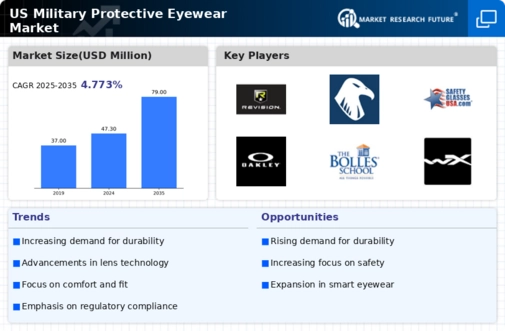Increased Military Spending
The market is experiencing growth due to increased military spending in the US. The Department of Defense has allocated substantial budgets for modernization and procurement of advanced equipment, including protective eyewear. In recent years, military budgets have seen an upward trend, with a reported increase of approximately 5% in 2025 alone. This financial commitment reflects a strategic focus on enhancing soldier safety and operational effectiveness. As a result, manufacturers are responding by innovating and producing eyewear that meets stringent military standards. The emphasis on quality and durability in military protective-eyewear is likely to drive demand, as armed forces prioritize equipment that can withstand harsh environments and provide optimal protection. Consequently, this trend is expected to bolster the military protective-eyewear market significantly.
Focus on Lightweight Materials
The military protective-eyewear market is being driven by a focus on lightweight materials that enhance comfort and usability. Traditional eyewear often compromises on weight, leading to discomfort during extended use. However, advancements in materials science have led to the development of lightweight yet durable materials that provide adequate protection without adding unnecessary weight. This shift is particularly relevant for military personnel who require eyewear that can be worn for long durations without fatigue. The demand for lightweight protective eyewear is likely to increase as military forces seek to improve the overall comfort and effectiveness of their equipment. Consequently, manufacturers are expected to prioritize the use of innovative materials in their designs, further propelling the military protective-eyewear market.
Rising Awareness of Eye Safety
There is a growing awareness of eye safety among military personnel, which is positively influencing the military protective-eyewear market. Training programs and safety protocols have increasingly emphasized the importance of protecting vision in combat and training scenarios. Reports indicate that eye injuries account for a notable percentage of injuries sustained in military operations, prompting a shift in focus towards protective eyewear. As military organizations recognize the long-term implications of eye injuries, the demand for high-quality protective eyewear is likely to rise. This heightened awareness is fostering a culture of safety, leading to increased procurement of advanced eyewear solutions that offer superior protection. Consequently, the military protective-eyewear market is poised for growth as military forces prioritize the health and safety of their personnel.
Regulatory Compliance and Standards
Regulatory compliance and adherence to safety standards are critical drivers in the military protective-eyewear market. The US military has established stringent guidelines for protective equipment, including eyewear, to ensure the safety and effectiveness of its personnel. Compliance with these regulations is not only mandatory but also influences procurement decisions. Manufacturers are required to meet specific performance criteria, which can include impact resistance, optical clarity, and UV protection. As military operations evolve, so too do the standards, necessitating continuous innovation and improvement in eyewear design. This regulatory landscape creates opportunities for manufacturers to differentiate their products based on compliance and performance, thereby driving growth in the military protective-eyewear market.
Technological Integration in Eyewear
The integration of advanced technologies into military protective-eyewear is a key driver of market growth. Innovations such as augmented reality (AR) and heads-up displays (HUD) are being incorporated into eyewear designs, enhancing situational awareness for military personnel. These technological advancements allow soldiers to access critical information without compromising their vision or safety. The military protective-eyewear market is witnessing a surge in demand for eyewear that not only protects but also enhances operational capabilities. As military operations become increasingly complex, the need for multifunctional eyewear is likely to grow. This trend suggests that manufacturers who invest in research and development to create technologically advanced eyewear will have a competitive edge in the military protective-eyewear market.






















Leave a Comment